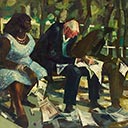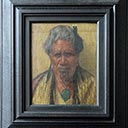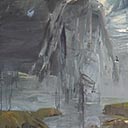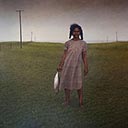Racecourse
81 x 99 cm
Languid. An antipodean exhaustion - half pleasure, half resignation. The variety of haptic and emotional sensations conveyed by this painting are exquisitely nuanced given the strident tonal, colour and shape contrasts. Garth Tapper (1927-1999) was a master of the gestures of every part of the body. An acute observer and constantly sketching his observations, he has captured the end-of-day, depleted-pockets postures of these three punters perfectly. Hands droop and barely have energy left to hold papers, betting chits, pens. Eyes gaze into the distance or into the form sheets, vacantly imagining what might have been. Bodies slump in on themselves with spent energy and heat-sapped resignation.
Garth Tapper studied at Elam in the late 1940s and then at the Slade - where he found the life drawing "intensive" - and Chelsea School of Fine Art in London in the early 1950s; and then took further studies in France, Spain and Italy, before returning to New Zealand where he taught and in 1964 commenced showing in solo exhibitions at the John Leech Gallery. The Racecourse scene could almost be anywhere, any racetrack, any close-of-day. But it is not. It has a distinctly southern air to it and for Tapper, painted when it was, it draws from the sketches he made during a very happy spell in Sydney in the previous year when he came in contact with what he considered to be "the real world of painting." That the three figures seem to take pleasure in this late afternoon heat and in this tired, worn out moment is resident in the artist's precise observation of people and in his handling of light and shade, costumes, even skin tones. But it is also the result of the artist's personal projection onto the scene as he looks back on his six months sabbatical in Australia (1974-75). In Sydney, where he and his family stayed in Clareville, North Sydney, and Tapper had exhibited at the Clareville Gallery and the Barefoot Gallery in Avalon, he was refreshed and revived. The new environment boosted his enthusiasm and gave him great motivation to paint.
The sabbatical was the moment he realised it would be possible to retire from teaching after 17 years at Elam and become a full-time artist at the age of 50; and a year after Racecourse was painted that is just what he did. In many ways, the handling of the punters - beaten but not down - and the significant scale of the work signal a new optimism in the artist. Even the sketches he made about this time, of his Elam students drawing, during his final year before retiring have a summery, optimist air. Tapper was ready for the change. Rob Garrett





